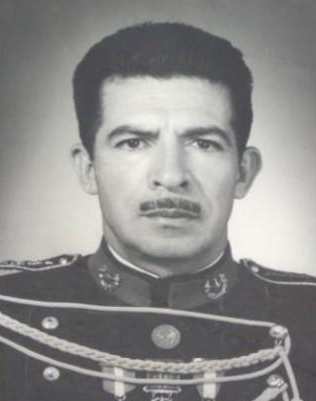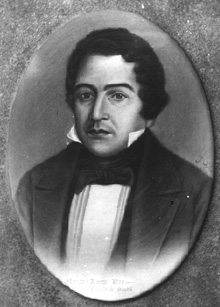|
Plan De Sánchez
Plan de Sánchez is a small village in the municipality of Rabinal, Baja Verapaz department, Guatemala. On July 18, 1982, while General Efraín Ríos Montt was President of Guatemala, a massacre was committed there by government forces during which over 200 people were killed. The massacre was a part of what is known as the scorched earth policy where the Guatemalan army eliminated up to 200,000 Mayan and indigenous peoples in a 36-year civil war until 1996. In 2000 President Alfonso Portillo admitted that the government was responsible for the massacre in the village. See also *Plan de Sánchez massacre The Plan de Sánchez massacre took place in the Guatemalan village of Plan de Sánchez, Baja Verapaz Departments of Guatemala, department, on 18 July 1982. Over 250 people (mostly women and children, and almost exclusively ethnic Achi people, Ach ... Locator maps * – Rabinal municipality Populated places in the Baja Verapaz Department {{Guatemala-geo-stub ... [...More Info...] [...Related Items...] OR: [Wikipedia] [Google] [Baidu] |
Rabinal
Rabinal is a small town, with a population of 15,157 (2018 census), Population of cities & towns in Guatemala located in the n department of Baja Verapaz, at . It serves as the administrative seat for the surrounding municipality of the same name. The municipality covers an area of 336 km2 with a population of 40,797 (2018 census). The local people are predominantly Achi Maya [...More Info...] [...Related Items...] OR: [Wikipedia] [Google] [Baidu] |
Baja Verapaz
Baja Verapaz () is a department in Guatemala. In 2018, the population of the department was 299,476. The capital is Salamá. 78.5% of the department’s population identifies as Maya, with 53% belonging to the Achi linguistic group. Baja Verapaz contains the Mario Dary Biotope Preserve, preserving the native flora and fauna of the region, especially the endangered national bird of Guatemala, the Resplendent Quetzal. Municipalities *Cubulco * Granados *Purulhá *Rabinal *Salamá * San Jerónimo *San Miguel Chicaj *Santa Cruz El Chol Santa Cruz El Chol () is a municipality in the Baja Verapaz department of Guatemala. It is situated at 1008 m above sea level and contains about 8817 people. It covers a terrain of 140 km² and its annual festival is held from December 6-Dec ... References External linksBaja Verapaz Website Departments of Guatemala {{Guatemala-geo-stub ... [...More Info...] [...Related Items...] OR: [Wikipedia] [Google] [Baidu] |
Guatemala
Guatemala, officially the Republic of Guatemala, is a country in Central America. It is bordered to the north and west by Mexico, to the northeast by Belize, to the east by Honduras, and to the southeast by El Salvador. It is hydrologically bordered to the south by the Pacific Ocean and to the northeast by the Gulf of Honduras. The territory of modern Guatemala hosted the core of the Maya civilization, which extended across Mesoamerica; in the 16th century, most of this was Spanish conquest of Guatemala, conquered by the Spanish and claimed as part of the viceroyalty of New Spain. Guatemala attained independence from Spain and Mexico in 1821. From 1823 to 1841, it was part of the Federal Republic of Central America. For the latter half of the 19th century, Guatemala suffered instability and civil strife. From the early 20th century, it was ruled by a series of dictators backed by the United States. In 1944, authoritarian leader Jorge Ubico was overthrown by a pro-democratic m ... [...More Info...] [...Related Items...] OR: [Wikipedia] [Google] [Baidu] |
Efraín Ríos Montt
José Efraín Ríos Montt (; 16 June 1926 – 1 April 2018) was a Guatemalan military officer, politician, and dictator who served as ''de facto'' President of Guatemala from 1982 to 1983. His brief tenure as chief executive was one of the bloodiest periods in the long-running Guatemalan Civil War. Ríos Montt's counter-insurgency strategies significantly weakened the Marxism, Marxist Guerrilla warfare, guerrillas organized under the umbrella of the Guatemalan National Revolutionary Unity (URNG) while also leading to accusations of war crimes and genocide perpetrated by the Armed Forces of Guatemala, Guatemalan Army under his leadership. Ríos Montt was a career army officer. He was director of the Guatemalan military academy and rose to the rank of brigadier general. He was briefly chief of staff of the Guatemalan army in 1973. However, he was soon forced out of the position over differences with the military high command. He ran for president in the 1974 Guatemalan general el ... [...More Info...] [...Related Items...] OR: [Wikipedia] [Google] [Baidu] |
President Of Guatemala
The president of Guatemala (), officially titled President of the Republic of Guatemala (), is the head of state and head of government of Guatemala, elected to a single four-year term. The position of President was created in 1839. Selection process Eligibility Article 185 of the Constitution, sets the following requirements to qualify for the presidency: * be Guatemalan of origin who is a citizen in good standing; * be at least 40 years old. A person who meets the above qualifications would, however, still be disqualified from holding the office of president if the individual: * Was the leader or the head of a coup d'état, armed revolution, or similar movement, that had altered the constitutional order, and as a result of their actions became the Head of Government; * Exercised the role of President or Vice President during an election, or at any point within the presidential period in which elections are conducted. * Are relatives of the incumbent president or vice p ... [...More Info...] [...Related Items...] OR: [Wikipedia] [Google] [Baidu] |
Plan De Sánchez Massacre
The Plan de Sánchez massacre took place in the Guatemalan village of Plan de Sánchez, Baja Verapaz Departments of Guatemala, department, on 18 July 1982. Over 250 people (mostly women and children, and almost exclusively ethnic Achi people, Achi Maya) were abused and murdered by members of the Military of Guatemala, armed forces and their paramilitary allies. The killings took place during one of the most violent phases of Guatemala's Guatemalan Civil War, Civil War, which pitted various groups of left-wing politics, left-wing Insurgency, insurgents against the government and the armed forces. After assuming power in March 1982, de facto President of Guatemala, President General, Gen. Efraín Ríos Montt embarked on a military campaign that largely succeeded in breaking the insurgency, but at a terrible cost in human lives and human rights violations. The massacre in Plan de Sánchez was an element in the government's scorched earth strategy, and the village was targeted because ... [...More Info...] [...Related Items...] OR: [Wikipedia] [Google] [Baidu] |
Maya Peoples
Maya () are an ethnolinguistic group of Indigenous peoples of the Americas, Indigenous peoples of Mesoamerica. The ancient Maya civilization was formed by members of this group, and today's Maya are generally descended from people who lived within that historical region. Today they inhabit southern Mexico, Guatemala, Belize, and westernmost El Salvador, Honduras, and the northernmost Nicaragua. "Maya" is a modern collective term for the peoples of the region; however, the term was not historically used by the Indigenous populations themselves. There was no common sense of identity or political unity among the distinct populations, societies and ethnic groups because they each had their own particular traditions, cultures and historical identity. It is estimated that seven million Maya were living in this area at the start of the 21st century. Guatemala, southern Mexico and the Yucatán Peninsula, Belize, El Salvador, western Honduras, and northern Nicaragua have managed to ma ... [...More Info...] [...Related Items...] OR: [Wikipedia] [Google] [Baidu] |
Indigenous Peoples Of The Americas
In the Americas, Indigenous peoples comprise the two continents' pre-Columbian inhabitants, as well as the ethnic groups that identify with them in the 15th century, as well as the ethnic groups that identify with the pre-Columbian population of the Americas as such. These populations exhibit significant diversity; some Indigenous peoples were historically hunter-gatherers, while others practiced agriculture and aquaculture. Various Indigenous societies developed complex social structures, including pre-contact monumental architecture, organized city, cities, city-states, chiefdoms, state (polity), states, monarchy, kingdoms, republics, confederation, confederacies, and empires. These societies possessed varying levels of knowledge in fields such as Pre-Columbian engineering in the Americas, engineering, Pre-Columbian architecture, architecture, mathematics, astronomy, History of writing, writing, physics, medicine, Pre-Columbian agriculture, agriculture, irrigation, geology, minin ... [...More Info...] [...Related Items...] OR: [Wikipedia] [Google] [Baidu] |
Guatemalan Civil War
The Guatemalan Civil War was fought from 1960 to 1996 between the government of Guatemala and various Left-wing politics, leftist rebel groups. The Guatemalan government forces committed Guatemalan genocide, genocide against the Maya population of Guatemala during the civil war and there were widespread human rights violations against civilians. The context of the struggle was based on longstanding issues over land distribution. Wealthy Guatemalans, mainly of White Latin Americans#Guatemala, European descent, and foreign companies like the American United Fruit Company had control over much of the land leading to conflicts with the rural, disproportionately indigenous, peasants who worked the land. Democratic elections in 1944 and 1951 which were during the Guatemalan Revolution had brought popular leftist governments to power, who sought to ameliorate working conditions and implement land distribution. A 1954 Guatemalan coup d'état, United States-backed coup d'état in 1954 inst ... [...More Info...] [...Related Items...] OR: [Wikipedia] [Google] [Baidu] |
Alfonso Portillo
Alfonso Antonio Portillo Cabrera (born 24 September 1951) is a Guatemalan politician who served as the 45th president of Guatemala from 2000 to 2004. He took office on 14 January 2000, representing the Guatemalan Republican Front (FRG), the party then led by retired general and deposed military ruler Efraín Ríos Montt (1926–2018). In 2014, ten years after his departure from the presidency, Portillo would plead guilty to corruption charges in a United States court. Early life and education Portillo was born in Zacapa. He obtained his academic qualifications in Mexico. He allegedly received a degree in social sciences from the Autonomous University of Guerrero (UAG) in Chilpancingo, Guerrero, and his doctorate from the National Autonomous University of Mexico (UNAM) in Mexico City. However, the veracity of such claims remains to be determined since no evidence has been provided to support them. Career In the late 1970s, he became involved with left-wing indigenous group ... [...More Info...] [...Related Items...] OR: [Wikipedia] [Google] [Baidu] |




